sensor FORD MAVERICK 2022 Owners Manual
[x] Cancel search | Manufacturer: FORD, Model Year: 2022, Model line: MAVERICK, Model: FORD MAVERICK 2022Pages: 533, PDF Size: 9.58 MB
Page 4 of 533
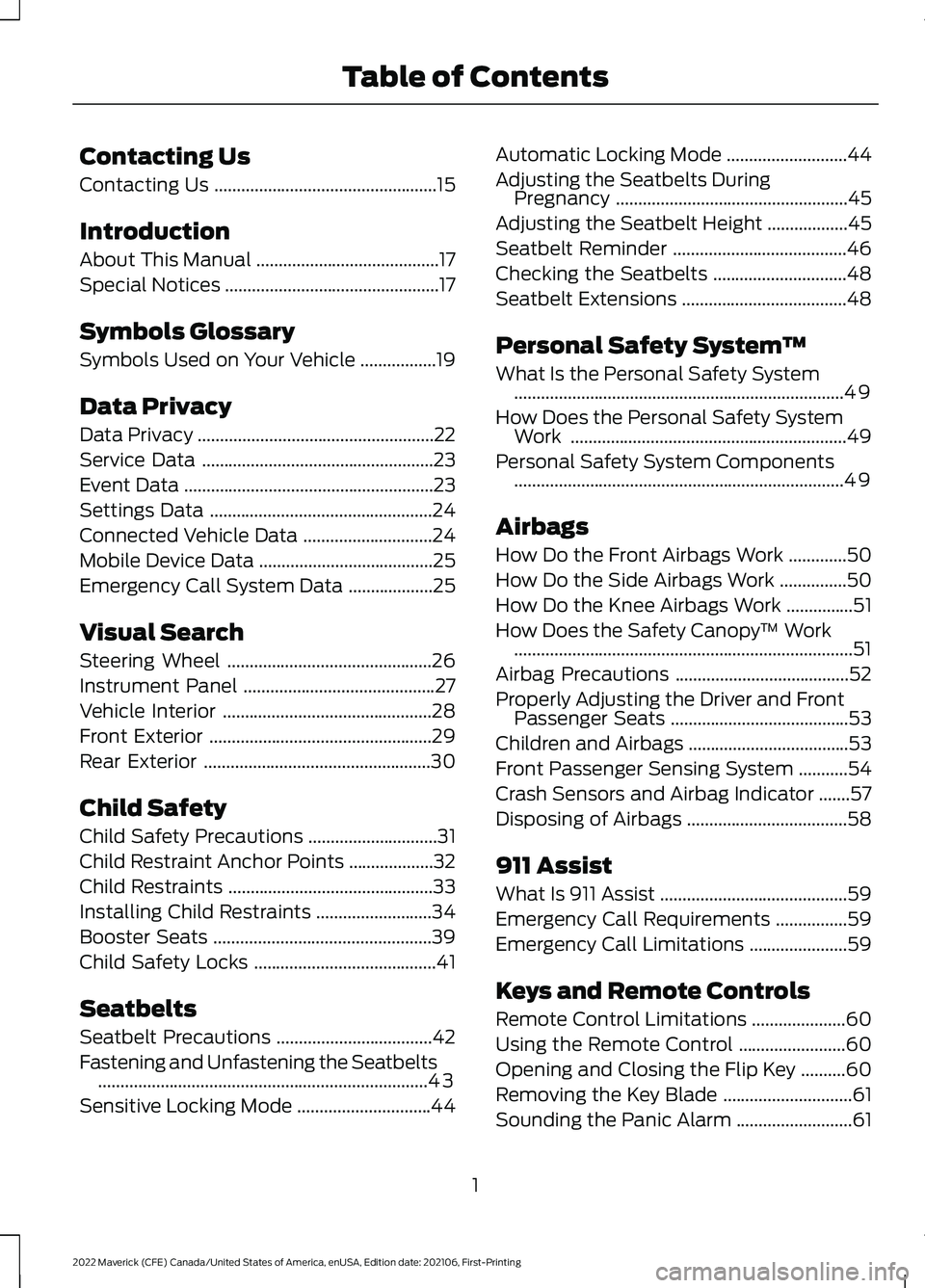
Contacting Us
Contacting Us
..................................................15
Introduction
About This Manual .........................................
17
Special Notices ................................................
17
Symbols Glossary
Symbols Used on Your Vehicle .................
19
Data Privacy
Data Privacy .....................................................
22
Service Data ....................................................
23
Event Data ........................................................
23
Settings Data ..................................................
24
Connected Vehicle Data .............................
24
Mobile Device Data .......................................
25
Emergency Call System Data ...................
25
Visual Search
Steering Wheel ..............................................
26
Instrument Panel ...........................................
27
Vehicle Interior ...............................................
28
Front Exterior ..................................................
29
Rear Exterior ...................................................
30
Child Safety
Child Safety Precautions .............................
31
Child Restraint Anchor Points ...................
32
Child Restraints ..............................................
33
Installing Child Restraints ..........................
34
Booster Seats .................................................
39
Child Safety Locks .........................................
41
Seatbelts
Seatbelt Precautions ...................................
42
Fastening and Unfastening the Seatbelts ........................................................................\
..
43
Sensitive Locking Mode ..............................
44Automatic Locking Mode
...........................
44
Adjusting the Seatbelts During Pregnancy ....................................................
45
Adjusting the Seatbelt Height ..................
45
Seatbelt Reminder .......................................
46
Checking the Seatbelts ..............................
48
Seatbelt Extensions .....................................
48
Personal Safety System ™
What Is the Personal Safety System ........................................................................\
..
49
How Does the Personal Safety System Work ..............................................................
49
Personal Safety System Components ........................................................................\
..
49
Airbags
How Do the Front Airbags Work .............
50
How Do the Side Airbags Work ...............
50
How Do the Knee Airbags Work ...............
51
How Does the Safety Canopy ™ Work
........................................................................\
....
51
Airbag Precautions .......................................
52
Properly Adjusting the Driver and Front Passenger Seats ........................................
53
Children and Airbags ....................................
53
Front Passenger Sensing System ...........
54
Crash Sensors and Airbag Indicator .......
57
Disposing of Airbags ....................................
58
911 Assist
What Is 911 Assist ..........................................
59
Emergency Call Requirements ................
59
Emergency Call Limitations ......................
59
Keys and Remote Controls
Remote Control Limitations .....................
60
Using the Remote Control ........................
60
Opening and Closing the Flip Key ..........
60
Removing the Key Blade .............................
61
Sounding the Panic Alarm ..........................
61
1
2022 Maverick (CFE) Canada/United States of America, enUSA, Edition date: 202106, First-Printing Table of Contents
Page 11 of 533
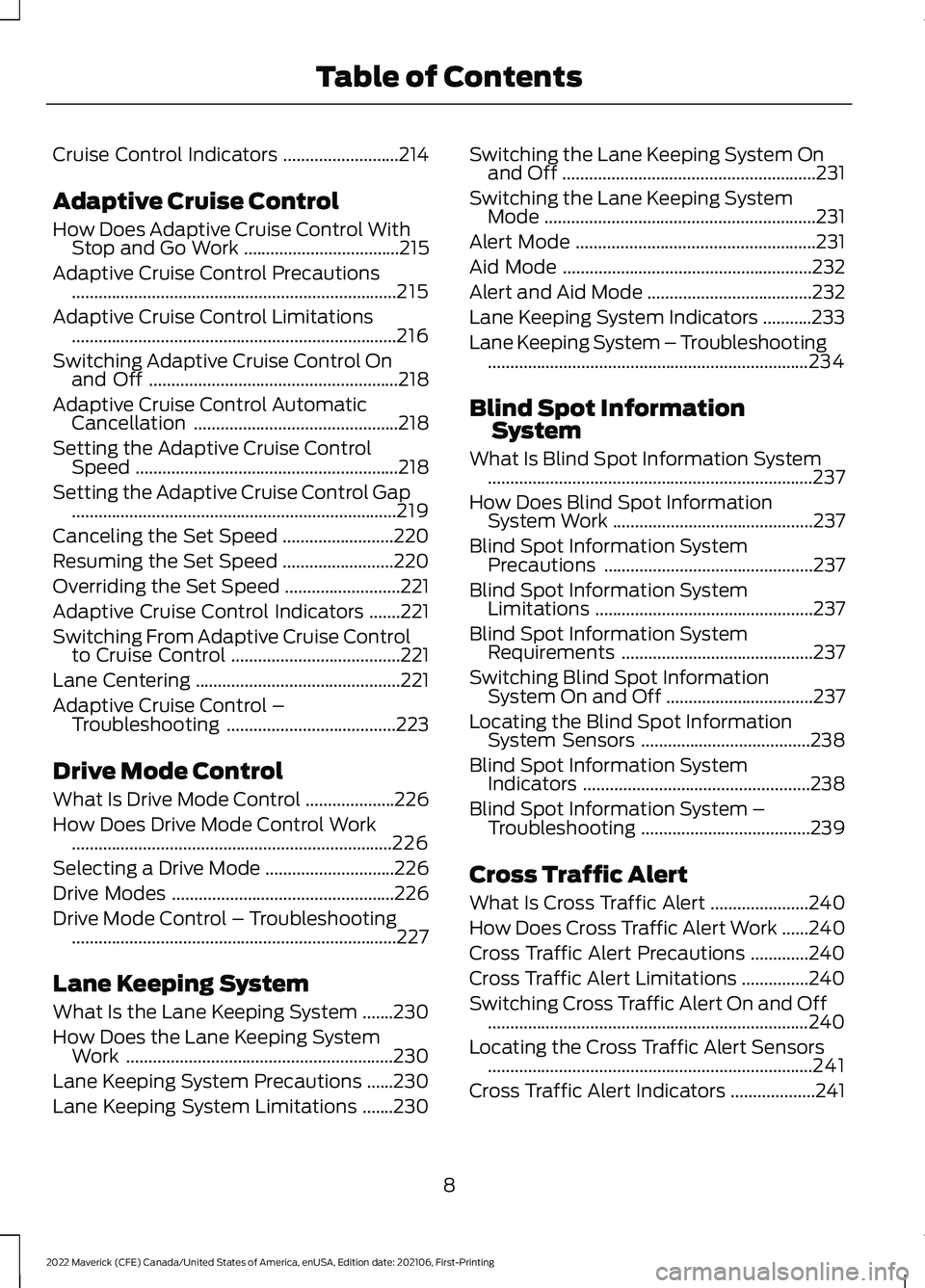
Cruise Control Indicators
..........................214
Adaptive Cruise Control
How Does Adaptive Cruise Control With Stop and Go Work ...................................
215
Adaptive Cruise Control Precautions ........................................................................\
.
215
Adaptive Cruise Control Limitations ........................................................................\
.
216
Switching Adaptive Cruise Control On and Off ........................................................
218
Adaptive Cruise Control Automatic Cancellation ..............................................
218
Setting the Adaptive Cruise Control Speed ...........................................................
218
Setting the Adaptive Cruise Control Gap ........................................................................\
.
219
Canceling the Set Speed .........................
220
Resuming the Set Speed .........................
220
Overriding the Set Speed ..........................
221
Adaptive Cruise Control Indicators .......
221
Switching From Adaptive Cruise Control to Cruise Control ......................................
221
Lane Centering ..............................................
221
Adaptive Cruise Control – Troubleshooting ......................................
223
Drive Mode Control
What Is Drive Mode Control ....................
226
How Does Drive Mode Control Work ........................................................................\
226
Selecting a Drive Mode .............................
226
Drive Modes ..................................................
226
Drive Mode Control – Troubleshooting ........................................................................\
.
227
Lane Keeping System
What Is the Lane Keeping System .......
230
How Does the Lane Keeping System Work ............................................................
230
Lane Keeping System Precautions ......
230
Lane Keeping System Limitations .......
230Switching the Lane Keeping System On
and Off .........................................................
231
Switching the Lane Keeping System Mode .............................................................
231
Alert Mode ......................................................
231
Aid Mode ........................................................
232
Alert and Aid Mode .....................................
232
Lane Keeping System Indicators ...........
233
Lane Keeping System – Troubleshooting ........................................................................\
234
Blind Spot Information System
What Is Blind Spot Information System ........................................................................\
.
237
How Does Blind Spot Information System Work .............................................
237
Blind Spot Information System Precautions ...............................................
237
Blind Spot Information System Limitations .................................................
237
Blind Spot Information System Requirements ...........................................
237
Switching Blind Spot Information System On and Off .................................
237
Locating the Blind Spot Information System Sensors ......................................
238
Blind Spot Information System Indicators ...................................................
238
Blind Spot Information System – Troubleshooting ......................................
239
Cross Traffic Alert
What Is Cross Traffic Alert ......................
240
How Does Cross Traffic Alert Work ......
240
Cross Traffic Alert Precautions .............
240
Cross Traffic Alert Limitations ...............
240
Switching Cross Traffic Alert On and Off ........................................................................\
240
Locating the Cross Traffic Alert Sensors ........................................................................\
.
241
Cross Traffic Alert Indicators ...................
241
8
2022 Maverick (CFE) Canada/United States of America, enUSA, Edition date: 202106, First-Printing Table of Contents
Page 12 of 533
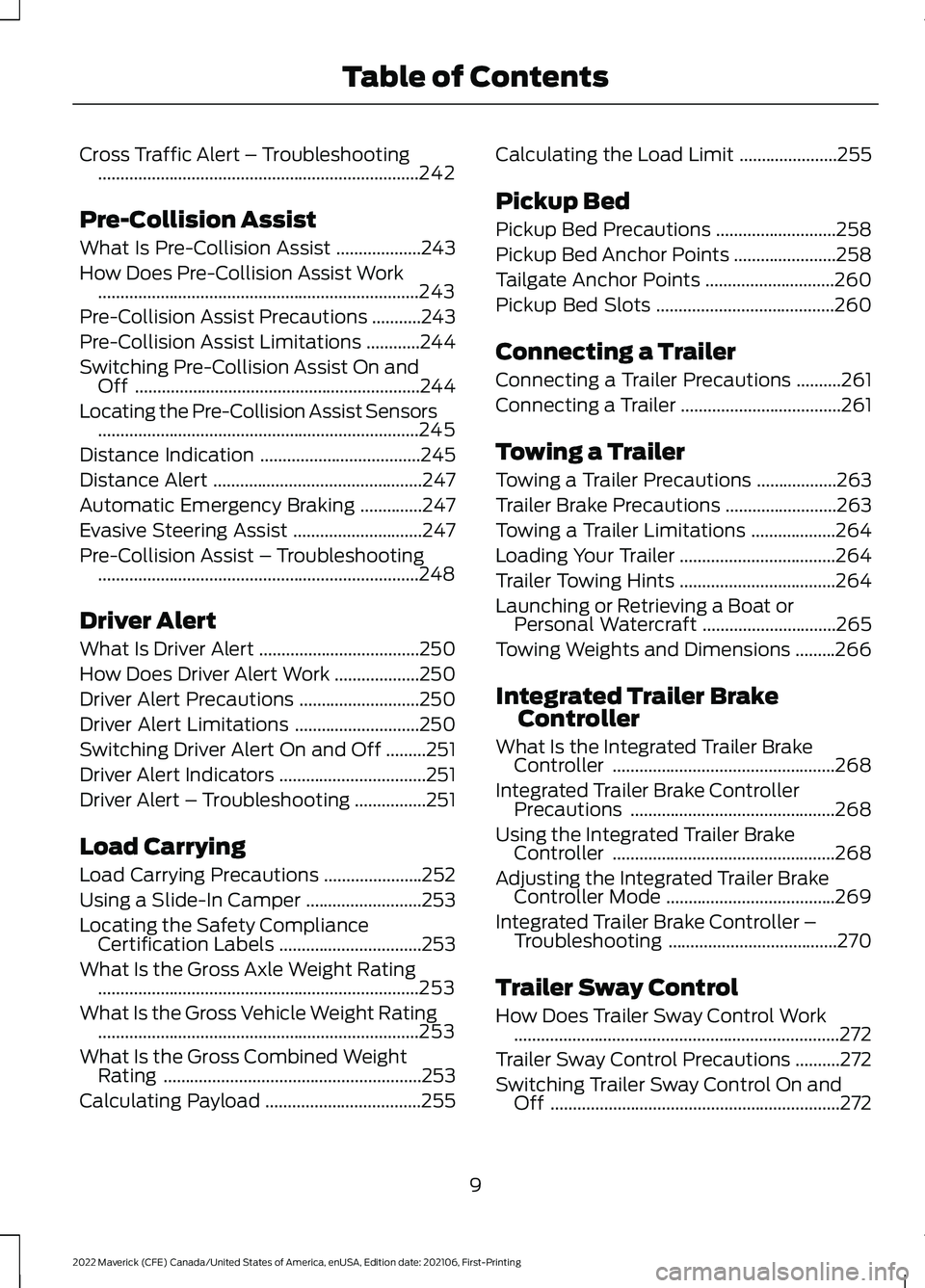
Cross Traffic Alert – Troubleshooting
........................................................................\
242
Pre-Collision Assist
What Is Pre-Collision Assist ...................
243
How Does Pre-Collision Assist Work ........................................................................\
243
Pre-Collision Assist Precautions ...........
243
Pre-Collision Assist Limitations ............
244
Switching Pre-Collision Assist On and Off ................................................................
244
Locating the Pre-Collision Assist Sensors ........................................................................\
245
Distance Indication ....................................
245
Distance Alert ...............................................
247
Automatic Emergency Braking ..............
247
Evasive Steering Assist .............................
247
Pre-Collision Assist – Troubleshooting ........................................................................\
248
Driver Alert
What Is Driver Alert ....................................
250
How Does Driver Alert Work ...................
250
Driver Alert Precautions ...........................
250
Driver Alert Limitations ............................
250
Switching Driver Alert On and Off .........
251
Driver Alert Indicators .................................
251
Driver Alert – Troubleshooting ................
251
Load Carrying
Load Carrying Precautions ......................
252
Using a Slide-In Camper ..........................
253
Locating the Safety Compliance Certification Labels ................................
253
What Is the Gross Axle Weight Rating ........................................................................\
253
What Is the Gross Vehicle Weight Rating ........................................................................\
253
What Is the Gross Combined Weight Rating ..........................................................
253
Calculating Payload ...................................
255Calculating the Load Limit
......................
255
Pickup Bed
Pickup Bed Precautions ...........................
258
Pickup Bed Anchor Points .......................
258
Tailgate Anchor Points .............................
260
Pickup Bed Slots ........................................
260
Connecting a Trailer
Connecting a Trailer Precautions ..........
261
Connecting a Trailer ....................................
261
Towing a Trailer
Towing a Trailer Precautions ..................
263
Trailer Brake Precautions .........................
263
Towing a Trailer Limitations ...................
264
Loading Your Trailer ...................................
264
Trailer Towing Hints ...................................
264
Launching or Retrieving a Boat or Personal Watercraft ..............................
265
Towing Weights and Dimensions .........
266
Integrated Trailer Brake Controller
What Is the Integrated Trailer Brake Controller ..................................................
268
Integrated Trailer Brake Controller Precautions ..............................................
268
Using the Integrated Trailer Brake Controller ..................................................
268
Adjusting the Integrated Trailer Brake Controller Mode ......................................
269
Integrated Trailer Brake Controller – Troubleshooting ......................................
270
Trailer Sway Control
How Does Trailer Sway Control Work ........................................................................\
.
272
Trailer Sway Control Precautions ..........
272
Switching Trailer Sway Control On and Off .................................................................
272
9
2022 Maverick (CFE) Canada/United States of America, enUSA, Edition date: 202106, First-Printing Table of Contents
Page 46 of 533
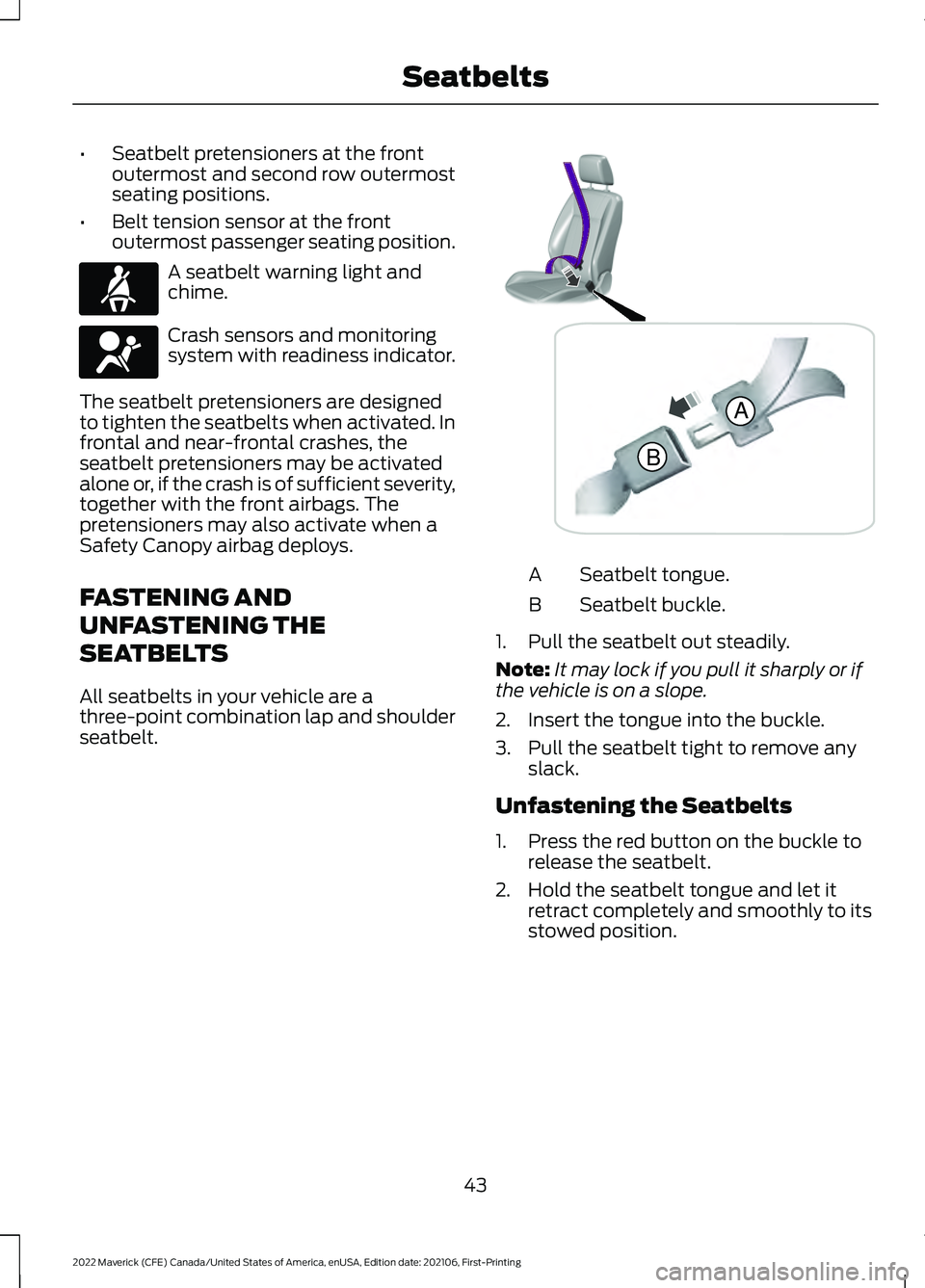
•
Seatbelt pretensioners at the front
outermost and second row outermost
seating positions.
• Belt tension sensor at the front
outermost passenger seating position. A seatbelt warning light and
chime.
Crash sensors and monitoring
system with readiness indicator.
The seatbelt pretensioners are designed
to tighten the seatbelts when activated. In
frontal and near-frontal crashes, the
seatbelt pretensioners may be activated
alone or, if the crash is of sufficient severity,
together with the front airbags. The
pretensioners may also activate when a
Safety Canopy airbag deploys.
FASTENING AND
UNFASTENING THE
SEATBELTS
All seatbelts in your vehicle are a
three-point combination lap and shoulder
seatbelt. Seatbelt tongue.
A
Seatbelt buckle.
B
1. Pull the seatbelt out steadily.
Note: It may lock if you pull it sharply or if
the vehicle is on a slope.
2. Insert the tongue into the buckle.
3. Pull the seatbelt tight to remove any slack.
Unfastening the Seatbelts
1. Press the red button on the buckle to release the seatbelt.
2. Hold the seatbelt tongue and let it retract completely and smoothly to its
stowed position.
43
2022 Maverick (CFE) Canada/United States of America, enUSA, Edition date: 202106, First-Printing SeatbeltsE71880 E67017 B
A E338014
Page 52 of 533
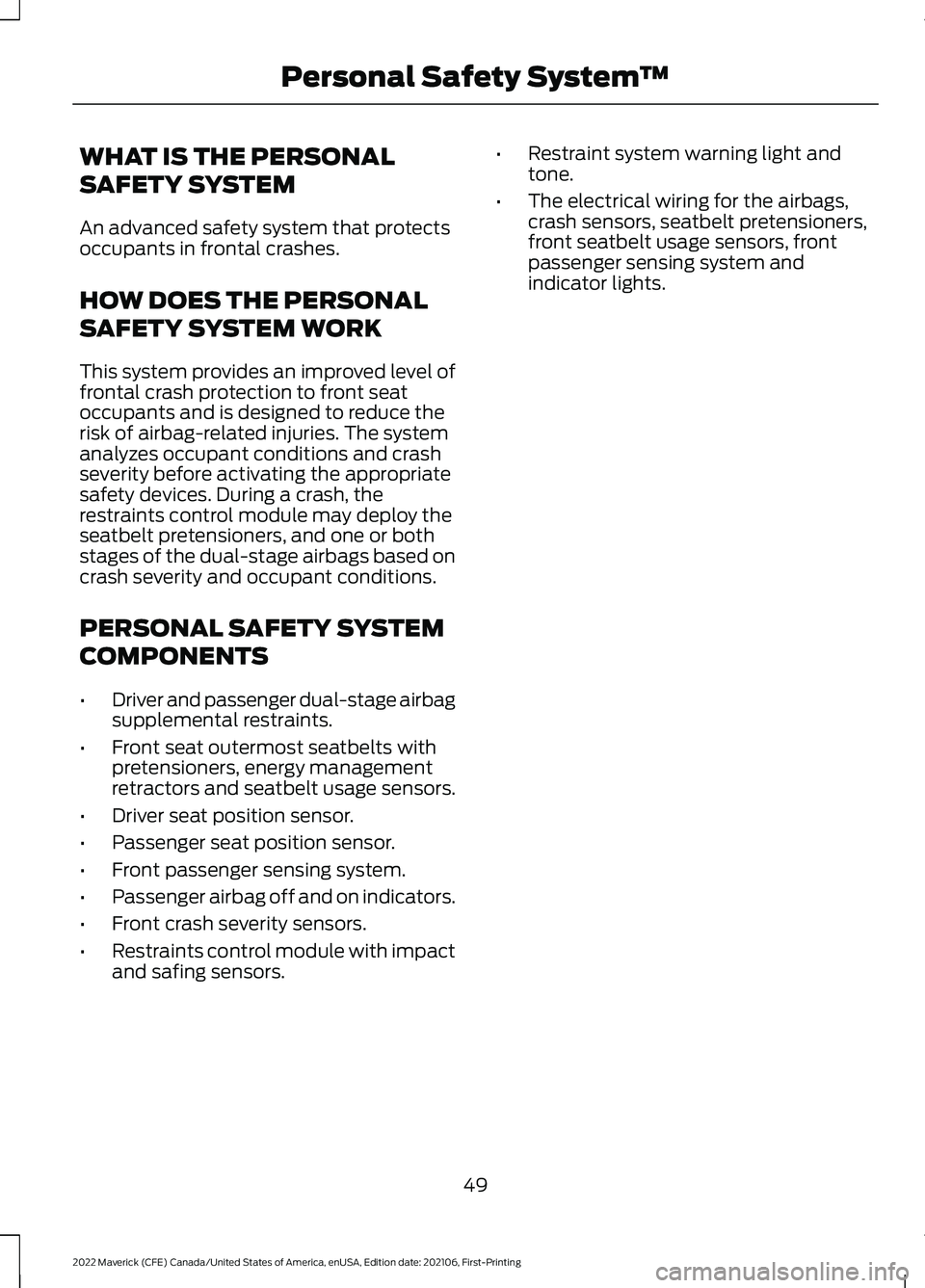
WHAT IS THE PERSONAL
SAFETY SYSTEM
An advanced safety system that protects
occupants in frontal crashes.
HOW DOES THE PERSONAL
SAFETY SYSTEM WORK
This system provides an improved level of
frontal crash protection to front seat
occupants and is designed to reduce the
risk of airbag-related injuries. The system
analyzes occupant conditions and crash
severity before activating the appropriate
safety devices. During a crash, the
restraints control module may deploy the
seatbelt pretensioners, and one or both
stages of the dual-stage airbags based on
crash severity and occupant conditions.
PERSONAL SAFETY SYSTEM
COMPONENTS
•
Driver and passenger dual-stage airbag
supplemental restraints.
• Front seat outermost seatbelts with
pretensioners, energy management
retractors and seatbelt usage sensors.
• Driver seat position sensor.
• Passenger seat position sensor.
• Front passenger sensing system.
• Passenger airbag off and on indicators.
• Front crash severity sensors.
• Restraints control module with impact
and safing sensors. •
Restraint system warning light and
tone.
• The electrical wiring for the airbags,
crash sensors, seatbelt pretensioners,
front seatbelt usage sensors, front
passenger sensing system and
indicator lights.
49
2022 Maverick (CFE) Canada/United States of America, enUSA, Edition date: 202106, First-Printing Personal Safety System
™
Page 53 of 533
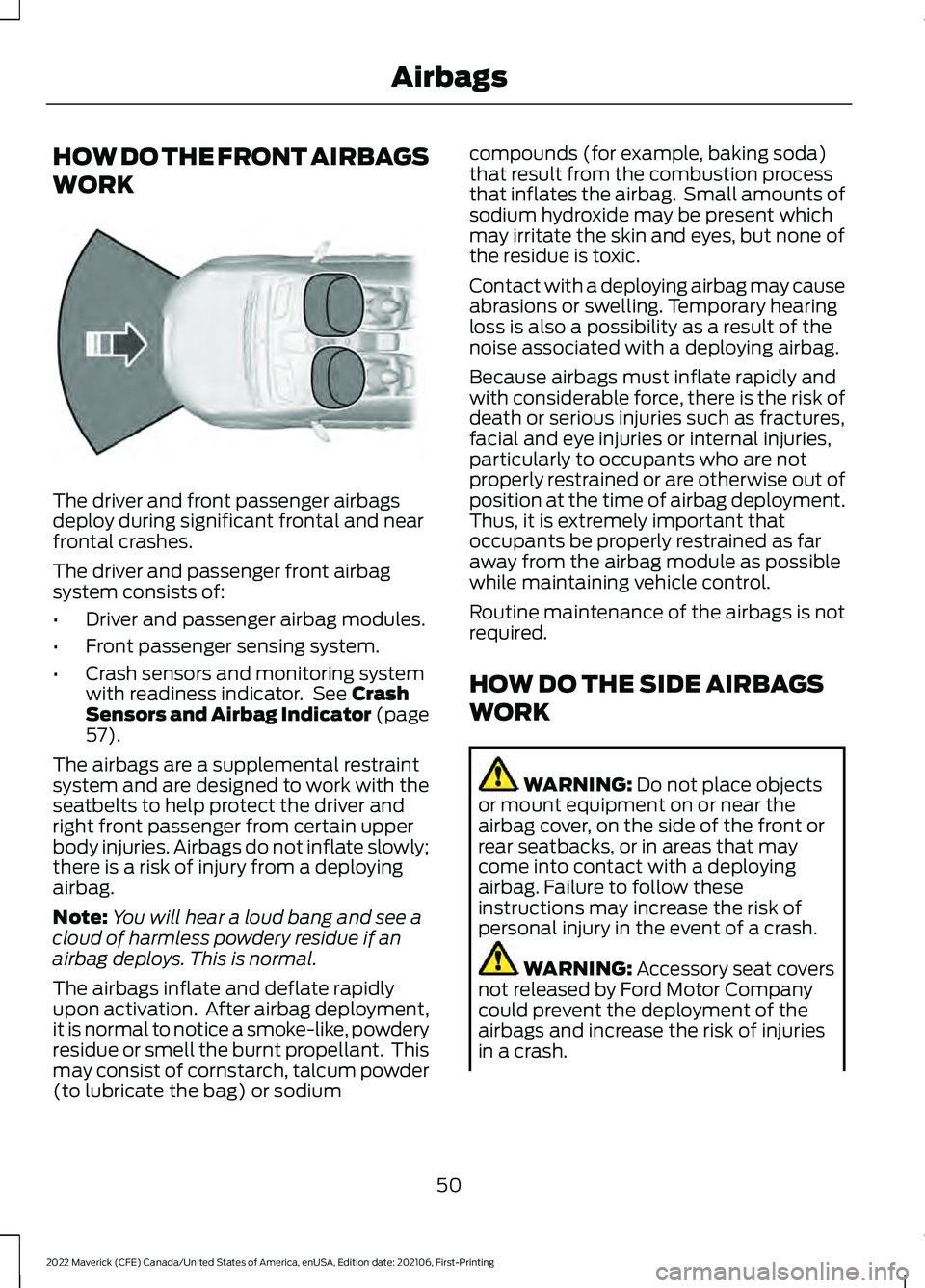
HOW DO THE FRONT AIRBAGS
WORK
The driver and front passenger airbags
deploy during significant frontal and near
frontal crashes.
The driver and passenger front airbag
system consists of:
•
Driver and passenger airbag modules.
• Front passenger sensing system.
• Crash sensors and monitoring system
with readiness indicator. See Crash
Sensors and Airbag Indicator (page
57
).
The airbags are a supplemental restraint
system and are designed to work with the
seatbelts to help protect the driver and
right front passenger from certain upper
body injuries. Airbags do not inflate slowly;
there is a risk of injury from a deploying
airbag.
Note: You will hear a loud bang and see a
cloud of harmless powdery residue if an
airbag deploys. This is normal.
The airbags inflate and deflate rapidly
upon activation. After airbag deployment,
it is normal to notice a smoke-like, powdery
residue or smell the burnt propellant. This
may consist of cornstarch, talcum powder
(to lubricate the bag) or sodium compounds (for example, baking soda)
that result from the combustion process
that inflates the airbag. Small amounts of
sodium hydroxide may be present which
may irritate the skin and eyes, but none of
the residue is toxic.
Contact with a deploying airbag may cause
abrasions or swelling. Temporary hearing
loss is also a possibility as a result of the
noise associated with a deploying airbag.
Because airbags must inflate rapidly and
with considerable force, there is the risk of
death or serious injuries such as fractures,
facial and eye injuries or internal injuries,
particularly to occupants who are not
properly restrained or are otherwise out of
position at the time of airbag deployment.
Thus, it is extremely important that
occupants be properly restrained as far
away from the airbag module as possible
while maintaining vehicle control.
Routine maintenance of the airbags is not
required.
HOW DO THE SIDE AIRBAGS
WORK
WARNING:
Do not place objects
or mount equipment on or near the
airbag cover, on the side of the front or
rear seatbacks, or in areas that may
come into contact with a deploying
airbag. Failure to follow these
instructions may increase the risk of
personal injury in the event of a crash. WARNING:
Accessory seat covers
not released by Ford Motor Company
could prevent the deployment of the
airbags and increase the risk of injuries
in a crash.
50
2022 Maverick (CFE) Canada/United States of America, enUSA, Edition date: 202106, First-Printing AirbagsE151127
Page 54 of 533
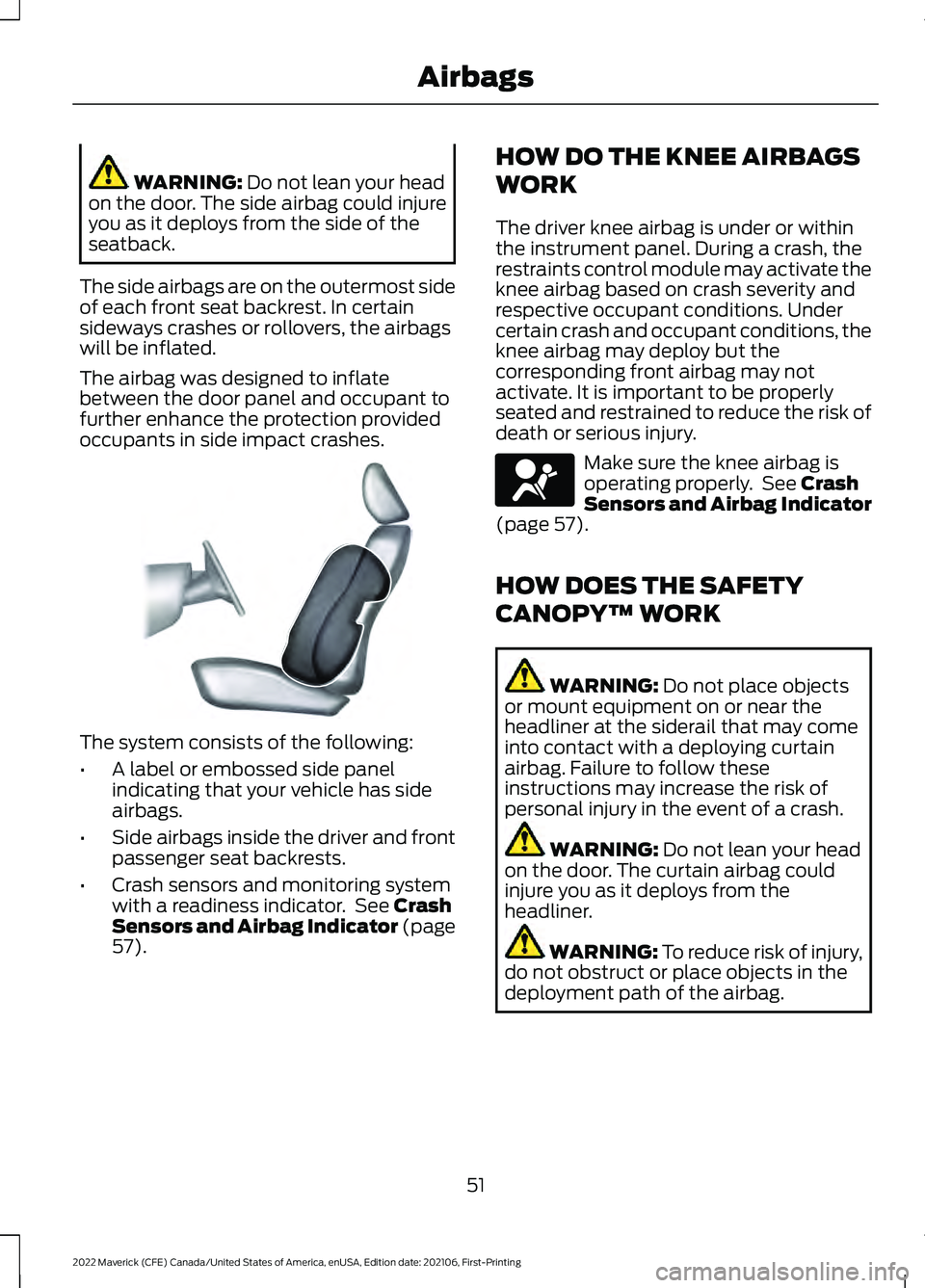
WARNING: Do not lean your head
on the door. The side airbag could injure
you as it deploys from the side of the
seatback.
The side airbags are on the outermost side
of each front seat backrest. In certain
sideways crashes or rollovers, the airbags
will be inflated.
The airbag was designed to inflate
between the door panel and occupant to
further enhance the protection provided
occupants in side impact crashes. The system consists of the following:
•
A label or embossed side panel
indicating that your vehicle has side
airbags.
• Side airbags inside the driver and front
passenger seat backrests.
• Crash sensors and monitoring system
with a readiness indicator. See
Crash
Sensors and Airbag Indicator (page
57
). HOW DO THE KNEE AIRBAGS
WORK
The driver knee airbag is under or within
the instrument panel. During a crash, the
restraints control module may activate the
knee airbag based on crash severity and
respective occupant conditions. Under
certain crash and occupant conditions, the
knee airbag may deploy but the
corresponding front airbag may not
activate. It is important to be properly
seated and restrained to reduce the risk of
death or serious injury.
Make sure the knee airbag is
operating properly. See
Crash
Sensors and Airbag Indicator
(page
57).
HOW DOES THE SAFETY
CANOPY™ WORK WARNING:
Do not place objects
or mount equipment on or near the
headliner at the siderail that may come
into contact with a deploying curtain
airbag. Failure to follow these
instructions may increase the risk of
personal injury in the event of a crash. WARNING:
Do not lean your head
on the door. The curtain airbag could
injure you as it deploys from the
headliner. WARNING:
To reduce risk of injury,
do not obstruct or place objects in the
deployment path of the airbag.
51
2022 Maverick (CFE) Canada/United States of America, enUSA, Edition date: 202106, First-Printing AirbagsE152533 E67017
Page 55 of 533
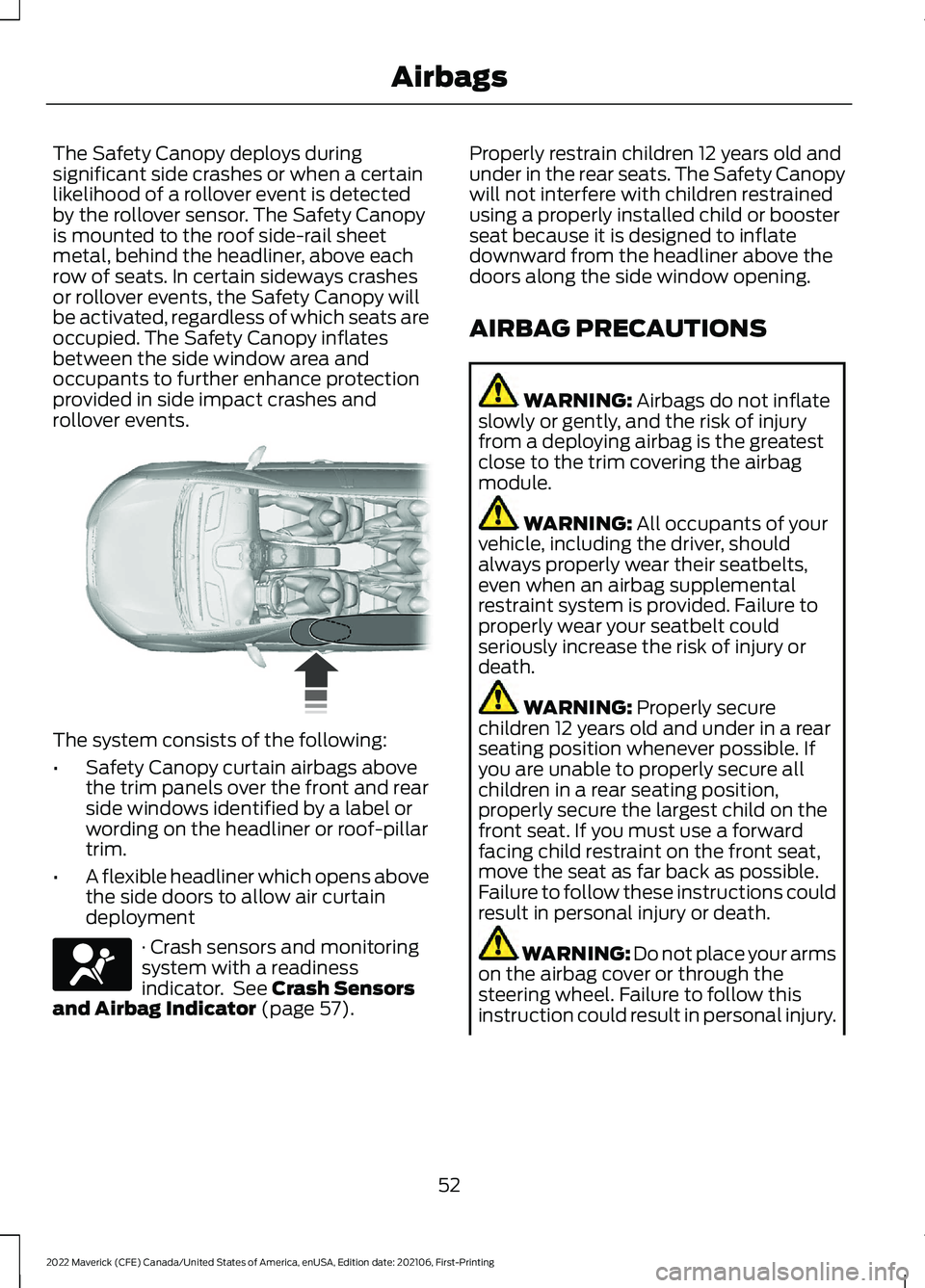
The Safety Canopy deploys during
significant side crashes or when a certain
likelihood of a rollover event is detected
by the rollover sensor. The Safety Canopy
is mounted to the roof side-rail sheet
metal, behind the headliner, above each
row of seats. In certain sideways crashes
or rollover events, the Safety Canopy will
be activated, regardless of which seats are
occupied. The Safety Canopy inflates
between the side window area and
occupants to further enhance protection
provided in side impact crashes and
rollover events.
The system consists of the following:
•
Safety Canopy curtain airbags above
the trim panels over the front and rear
side windows identified by a label or
wording on the headliner or roof-pillar
trim.
• A flexible headliner which opens above
the side doors to allow air curtain
deployment · Crash sensors and monitoring
system with a readiness
indicator. See Crash Sensors
and Airbag Indicator (page 57). Properly restrain children 12 years old and
under in the rear seats. The Safety Canopy
will not interfere with children restrained
using a properly installed child or booster
seat because it is designed to inflate
downward from the headliner above the
doors along the side window opening.
AIRBAG PRECAUTIONS
WARNING:
Airbags do not inflate
slowly or gently, and the risk of injury
from a deploying airbag is the greatest
close to the trim covering the airbag
module. WARNING:
All occupants of your
vehicle, including the driver, should
always properly wear their seatbelts,
even when an airbag supplemental
restraint system is provided. Failure to
properly wear your seatbelt could
seriously increase the risk of injury or
death. WARNING:
Properly secure
children 12 years old and under in a rear
seating position whenever possible. If
you are unable to properly secure all
children in a rear seating position,
properly secure the largest child on the
front seat. If you must use a forward
facing child restraint on the front seat,
move the seat as far back as possible.
Failure to follow these instructions could
result in personal injury or death. WARNING:
Do not place your arms
on the airbag cover or through the
steering wheel. Failure to follow this
instruction could result in personal injury.
52
2022 Maverick (CFE) Canada/United States of America, enUSA, Edition date: 202106, First-Printing Airbags E75004 E67017
Page 57 of 533
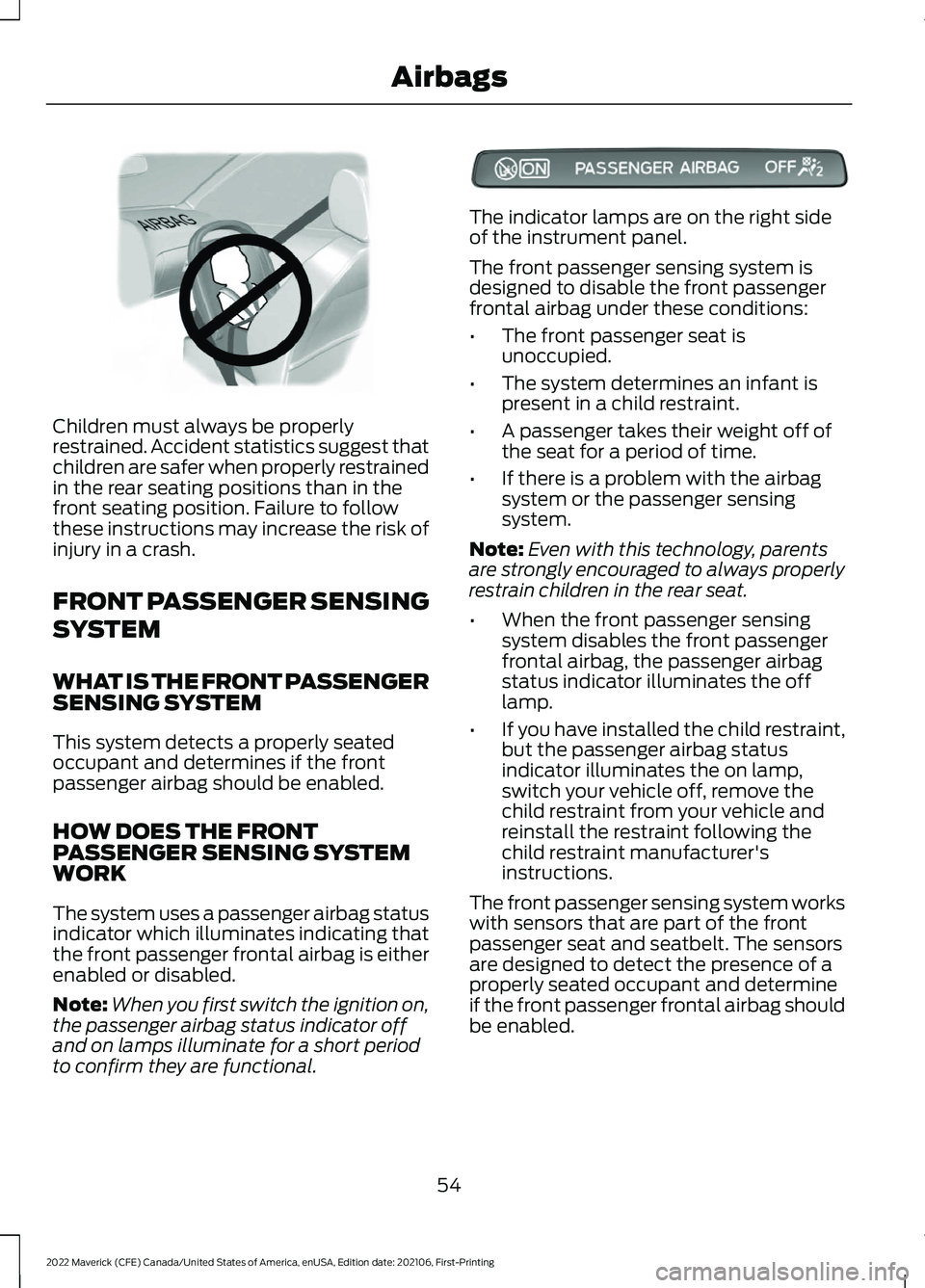
Children must always be properly
restrained. Accident statistics suggest that
children are safer when properly restrained
in the rear seating positions than in the
front seating position. Failure to follow
these instructions may increase the risk of
injury in a crash.
FRONT PASSENGER SENSING
SYSTEM
WHAT IS THE FRONT PASSENGER
SENSING SYSTEM
This system detects a properly seated
occupant and determines if the front
passenger airbag should be enabled.
HOW DOES THE FRONT
PASSENGER SENSING SYSTEM
WORK
The system uses a passenger airbag status
indicator which illuminates indicating that
the front passenger frontal airbag is either
enabled or disabled.
Note:
When you first switch the ignition on,
the passenger airbag status indicator off
and on lamps illuminate for a short period
to confirm they are functional. The indicator lamps are on the right side
of the instrument panel.
The front passenger sensing system is
designed to disable the front passenger
frontal airbag under these conditions:
•
The front passenger seat is
unoccupied.
• The system determines an infant is
present in a child restraint.
• A passenger takes their weight off of
the seat for a period of time.
• If there is a problem with the airbag
system or the passenger sensing
system.
Note: Even with this technology, parents
are strongly encouraged to always properly
restrain children in the rear seat.
• When the front passenger sensing
system disables the front passenger
frontal airbag, the passenger airbag
status indicator illuminates the off
lamp.
• If you have installed the child restraint,
but the passenger airbag status
indicator illuminates the on lamp,
switch your vehicle off, remove the
child restraint from your vehicle and
reinstall the restraint following the
child restraint manufacturer's
instructions.
The front passenger sensing system works
with sensors that are part of the front
passenger seat and seatbelt. The sensors
are designed to detect the presence of a
properly seated occupant and determine
if the front passenger frontal airbag should
be enabled.
54
2022 Maverick (CFE) Canada/United States of America, enUSA, Edition date: 202106, First-Printing AirbagsE142846 E351638
Page 58 of 533
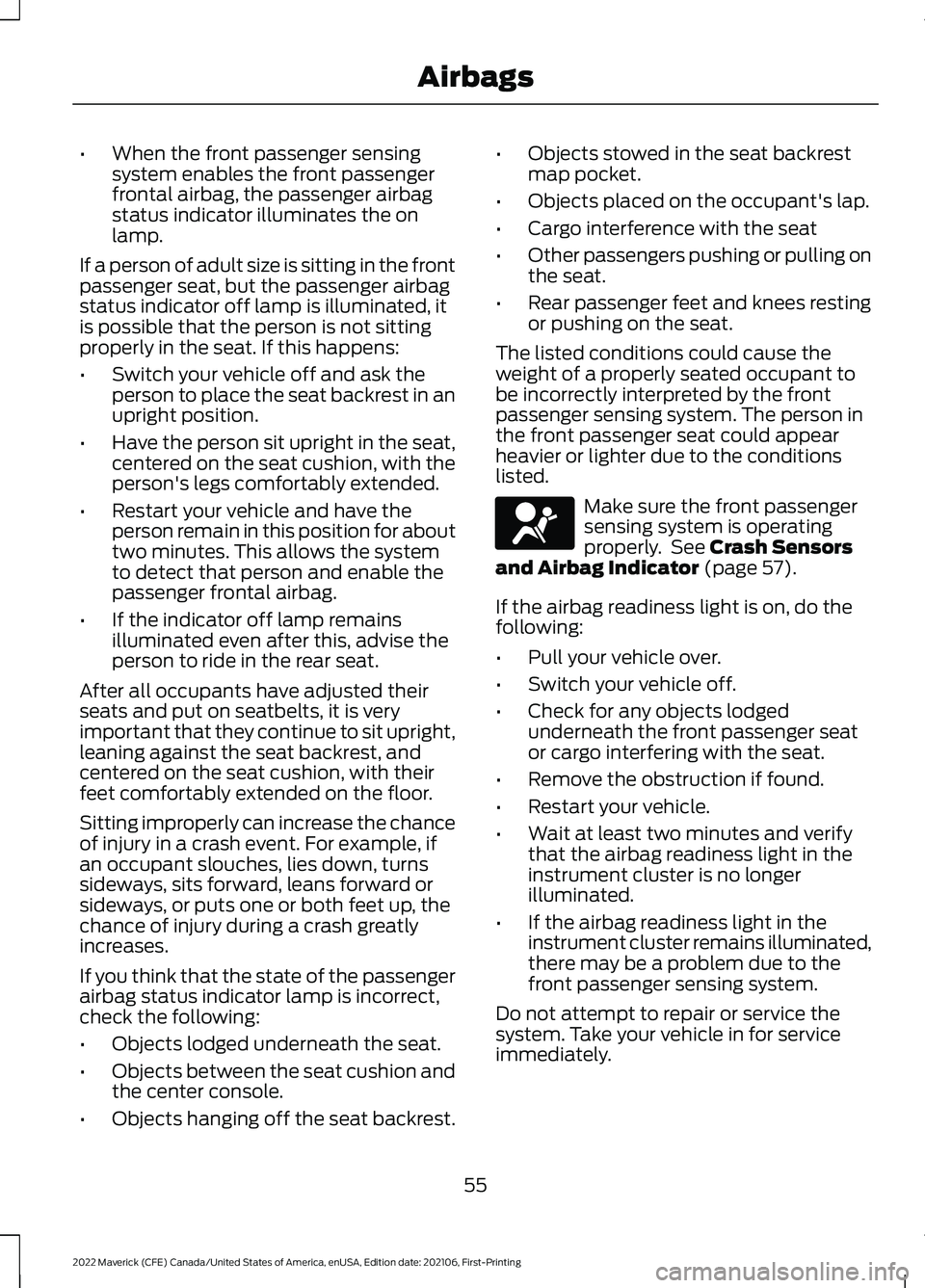
•
When the front passenger sensing
system enables the front passenger
frontal airbag, the passenger airbag
status indicator illuminates the on
lamp.
If a person of adult size is sitting in the front
passenger seat, but the passenger airbag
status indicator off lamp is illuminated, it
is possible that the person is not sitting
properly in the seat. If this happens:
• Switch your vehicle off and ask the
person to place the seat backrest in an
upright position.
• Have the person sit upright in the seat,
centered on the seat cushion, with the
person's legs comfortably extended.
• Restart your vehicle and have the
person remain in this position for about
two minutes. This allows the system
to detect that person and enable the
passenger frontal airbag.
• If the indicator off lamp remains
illuminated even after this, advise the
person to ride in the rear seat.
After all occupants have adjusted their
seats and put on seatbelts, it is very
important that they continue to sit upright,
leaning against the seat backrest, and
centered on the seat cushion, with their
feet comfortably extended on the floor.
Sitting improperly can increase the chance
of injury in a crash event. For example, if
an occupant slouches, lies down, turns
sideways, sits forward, leans forward or
sideways, or puts one or both feet up, the
chance of injury during a crash greatly
increases.
If you think that the state of the passenger
airbag status indicator lamp is incorrect,
check the following:
• Objects lodged underneath the seat.
• Objects between the seat cushion and
the center console.
• Objects hanging off the seat backrest. •
Objects stowed in the seat backrest
map pocket.
• Objects placed on the occupant's lap.
• Cargo interference with the seat
• Other passengers pushing or pulling on
the seat.
• Rear passenger feet and knees resting
or pushing on the seat.
The listed conditions could cause the
weight of a properly seated occupant to
be incorrectly interpreted by the front
passenger sensing system. The person in
the front passenger seat could appear
heavier or lighter due to the conditions
listed. Make sure the front passenger
sensing system is operating
properly. See Crash Sensors
and Airbag Indicator (page 57).
If the airbag readiness light is on, do the
following:
• Pull your vehicle over.
• Switch your vehicle off.
• Check for any objects lodged
underneath the front passenger seat
or cargo interfering with the seat.
• Remove the obstruction if found.
• Restart your vehicle.
• Wait at least two minutes and verify
that the airbag readiness light in the
instrument cluster is no longer
illuminated.
• If the airbag readiness light in the
instrument cluster remains illuminated,
there may be a problem due to the
front passenger sensing system.
Do not attempt to repair or service the
system. Take your vehicle in for service
immediately.
55
2022 Maverick (CFE) Canada/United States of America, enUSA, Edition date: 202106, First-Printing AirbagsE67017